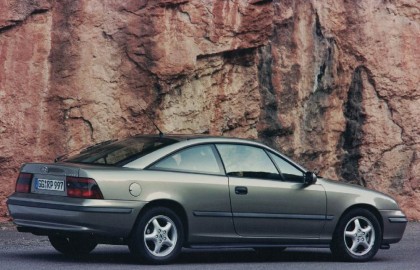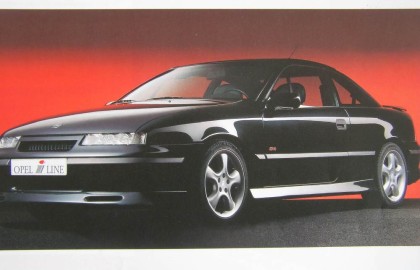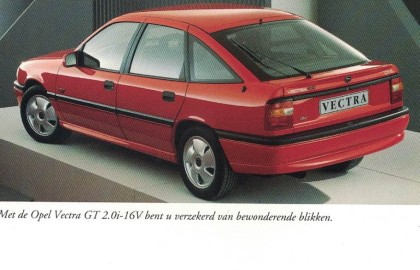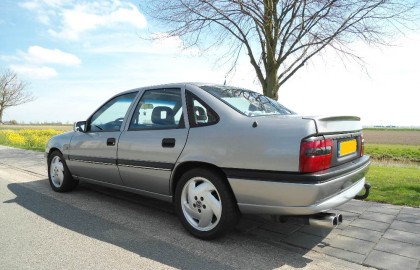Calibra 1988-1997
In the late '80s Manta was one of the last Opels to have rear-wheel drive. A successor should be able to compete with the advanced Japanese manufacturers, especially those who with their sport models, showed that front-wheel drive and good sportsmanship could work very well together.
Opel introduced the Calibra in 1989, and settled straight away a new record with a drag
coefficient of 0.26. This was achieved with a low front and a receding drop-shaped roof line. Like the chassis, instrumentation and the interior, engines were based on the one year previously released Vectra.
Available were a 20i-8V (115hp), a 20i-16v-(150 hp)- with a standard 5-speed gearbox.
Starting from 1992 the following engines were also available: the 2.5 V6 (170hp) and 20i-16v Turbo, (204pk) 4x4,
Also a standard ABS braking system, plus an optional 4x4 system could be had. The Opel Calibra proved that Opel could design and construct a balanced and beautiful coupe, after a decade of extremely overpowered GSI variations based on compact 3 and 5 door models.
In 1995 "Sondern 'models were offered in the versions of "Young" Classic' en' DTM '(16V turbo 204pk), right at the end of the production period in 1996.
In 1997 it was the end of the Calibra, and the Astra G continued with the Coupe.
Vectra A 1988-1995
The Vectra was introduced in 1988. With its new type name Opel was showing that it had nothing to do with its predecessor, the Ascona. In the UK the Opel Vectra A was sold under the name Vauxhall Cavalier.
After the introduction of the four door sedan, a five door hatchback followed quickly. The equipment levels were GL, GLS, GT and CD. The extensive attention paid to streamlined forms led to a Cw-value of 0.29.
All the available engines come with a catalytic converter, electronic injection and electronic ignition. The basic engine became a 1.6i (1.598 cc) and 75 hp. Thereafter followed the 1.8i (1.796cc) with 90 hp and the 2.0i (1.998cc) with 115 hp. The top model, the Vectra 2000, had a 20-16v with 150 hp and impressive performance: 0-100 km/hour in 9 seconds with a top speed of 217 km/hour. The Vectra 2000 was equipped with a different bumper and spoiler package.
The Vectra 4WD became the top model, first becoming available in 1989 with a 20-8v or 20-16v engine and four wheel drive.
In 1992 the Vectra A underwent a facelift where the lights on the fore and rear came in for some small changes. The headlights and the indicators got a little ‘bend’ horizontally which ran on into the grille. The rear lights also had a minor change with a small black plastic element and a bend/curve at the same height as the rear light and the indicators. Bumpers in the body colour became standard in all models from GL to CDX. The new Ecotec engines also became available, the 2.0 with 100 kw/136 hp and the 2.5 V6 with 125 kw/170 hp.
A lot of Vectras were purchased commercially, especially by companies with large fleets. With the arrival of the Vectra B in 1995, 1,975,579 vehicles had been built.




